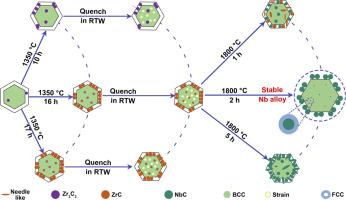当前位置:
X-MOL 学术
›
J. Mater. Sci. Technol.
›
论文详情
Our official English website, www.x-mol.net, welcomes your
feedback! (Note: you will need to create a separate account there.)
High-performance Nb alloy featuring a hierarchical carbides configuration for elevated-temperature applications
Journal of Materials Science & Technology ( IF 11.2 ) Pub Date : 2024-10-23 , DOI: 10.1016/j.jmst.2024.08.039 Yafang Zhang, Lairong Xiao, Zhenyang Cai, Ruiyang Xiao, Maokun Yin, Xing Li, Yiqian Fu, Xiangchen Xiao, Yuxiang Jiang, Zhenwu Peng, Sainan Liu, Xiaojun Zhao, Wei Li, Miao Song
Journal of Materials Science & Technology ( IF 11.2 ) Pub Date : 2024-10-23 , DOI: 10.1016/j.jmst.2024.08.039 Yafang Zhang, Lairong Xiao, Zhenyang Cai, Ruiyang Xiao, Maokun Yin, Xing Li, Yiqian Fu, Xiangchen Xiao, Yuxiang Jiang, Zhenwu Peng, Sainan Liu, Xiaojun Zhao, Wei Li, Miao Song

|
In aerospace, BBC-Nb alloys confront notable challenges in thermal stability and toughness under cyclic fatigue at varying temperatures. Insufficient thermal stability and expedited coalescence of precipitates substantially accelerates the degradation of alloys at elevated temperatures. Here, a Nb alloy with impressive thermal stability and mechanical properties was designed using theoretical calculations and a two-step graded heat treatment process. The superlative properties of the Nb alloy are primarily associated with the NbC hierarchical structures, i.e., stable nanoparticles in Nb-BCC grains and discontinuous microparticles at grain boundaries (GBs). The hierarchical carbides configuration avoids continuous precipitation of carbides at GBs and preferential coarsening within the grains. The process involves precipitating ZrC nanoparticles at 1350 °C, then stabilizing NbC at 1800 °C by replacing Zr with Nb. Nb-FCC nanophases enveloping NbC prevent coarsening and have strong relationships with both NbC nanoparticles and matrix. The concept of fine-tuning NbC precipitation within grains and introducing NbC at GBs with a substitution method offers a strategy for high-strength, heat-resistant materials.
中文翻译:

高性能 Nb 合金,采用分层碳化物配置,适用于高温应用
在航空航天领域,BBC-Nb 合金在不同温度下的循环疲劳下的热稳定性和韧性方面面临着显著的挑战。热稳定性不足和析出物加速聚结会大大加速合金在高温下的降解。在这里,使用理论计算和两步分级热处理工艺设计了具有令人印象深刻的热稳定性和机械性能的 Nb 合金。Nb 合金的最高性能主要与 NbC 多级结构有关,即 Nb-BCC 晶粒中稳定的纳米颗粒和晶界 (GB) 处的不连续微粒。多级碳化物配置避免了碳化物在 GB 处的连续沉淀和晶粒内的优先粗化。该过程包括在 1350 °C 沉淀 ZrC 纳米颗粒,然后通过用 Nb 代替 Zr 在 1800 °C 稳定 NbC。包裹 NbC 的 Nb-FCC 纳米相可防止粗化,并与 NbC 纳米颗粒和基质具有很强的关系。微调晶粒内 NbC 沉淀并使用取代方法在 GB 处引入 NbC 的概念为高强度、耐热材料提供了一种策略。
更新日期:2024-10-23
中文翻译:

高性能 Nb 合金,采用分层碳化物配置,适用于高温应用
在航空航天领域,BBC-Nb 合金在不同温度下的循环疲劳下的热稳定性和韧性方面面临着显著的挑战。热稳定性不足和析出物加速聚结会大大加速合金在高温下的降解。在这里,使用理论计算和两步分级热处理工艺设计了具有令人印象深刻的热稳定性和机械性能的 Nb 合金。Nb 合金的最高性能主要与 NbC 多级结构有关,即 Nb-BCC 晶粒中稳定的纳米颗粒和晶界 (GB) 处的不连续微粒。多级碳化物配置避免了碳化物在 GB 处的连续沉淀和晶粒内的优先粗化。该过程包括在 1350 °C 沉淀 ZrC 纳米颗粒,然后通过用 Nb 代替 Zr 在 1800 °C 稳定 NbC。包裹 NbC 的 Nb-FCC 纳米相可防止粗化,并与 NbC 纳米颗粒和基质具有很强的关系。微调晶粒内 NbC 沉淀并使用取代方法在 GB 处引入 NbC 的概念为高强度、耐热材料提供了一种策略。































 京公网安备 11010802027423号
京公网安备 11010802027423号